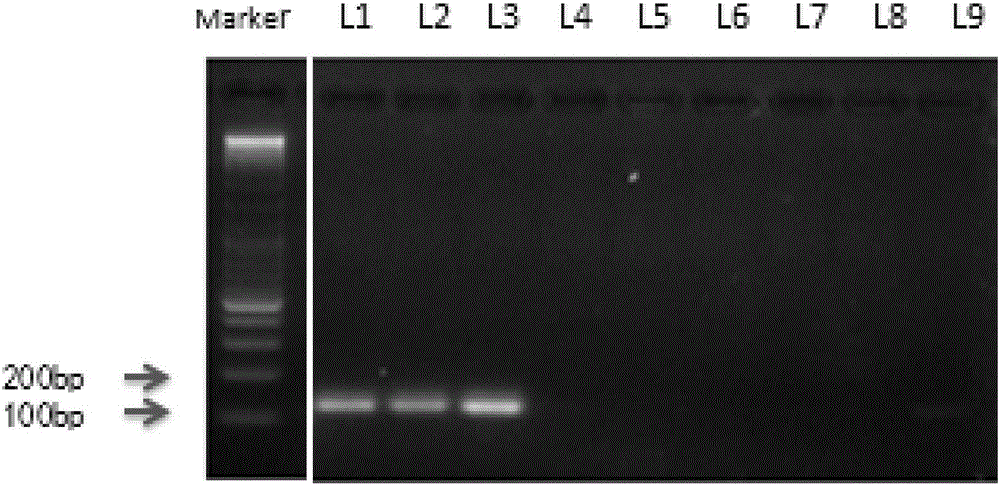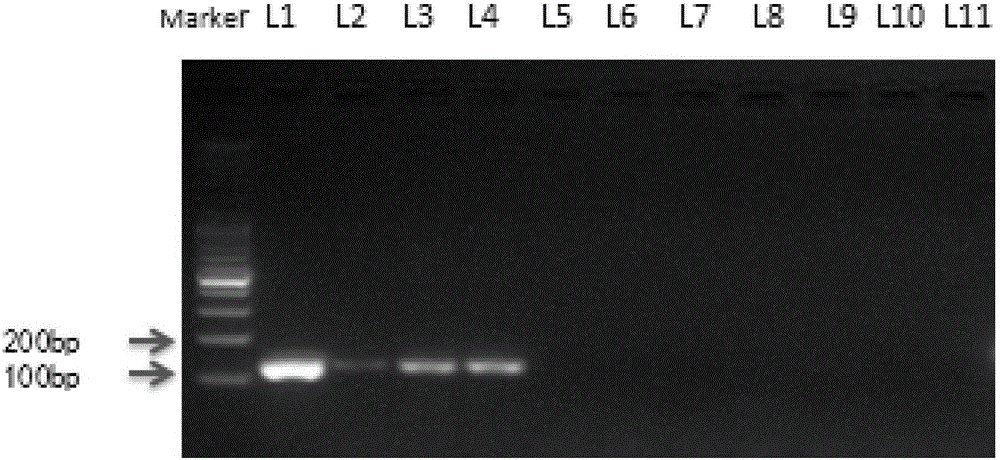Method for measuring intestinal tract setting capacity of lactobacillus
A determination method, the technology of Lactobacillus, applied in the field of microorganisms, can solve the problems of cumbersome operation, heavy workload, high cost, etc., and achieve the effects of high detection accuracy, fast operation, and reduced experiment cycle
- Summary
- Abstract
- Description
- Claims
- Application Information
AI Technical Summary
Problems solved by technology
Method used
Image
Examples
Embodiment 1
[0099] Example 1 Determination of Lactobacillus Intestinal Colonization Ability in Mice
[0100] SPF (Specific Pathogen Free) mice were used as the experimental model, and the colonization ability of the mice in the intestinal tract was determined by gavage of the mixed bacterial solution and later collection and detection of the amount of these six bacteria in the feces.
[0101] (1) Prepare six kinds of Lactobacillus bacteria powders of Lactobacillus plantarum, Lactobacillus casei, Lactobacillus fermentum, Lactobacillus rhamnosus, Lactobacillus helveticus and Lactobacillus bulgaricus respectively, count the number of viable bacteria in the bacterial powder by plate counting, and prepare The mixed bacteria powder of six kinds of Lactobacillus ensures that the concentration of each bacteria is the same, and the mixed bacteria powder is stored at -20°C for later use.
[0102] (2) Purchase 4-6 week-old SPF mice and raise them in a barrier environment in the experimental animal c...
Embodiment 2
[0112]Example 2 Determination of Lactobacillus Colonization Ability in Human Intestines
[0113] Healthy adults were used as the experimental subjects, and the colonization ability of the strains in the human intestinal tract was determined by administering the mixed bacterial solution and later collecting and detecting the amount of these six bacteria in human feces.
[0114] (1) Prepare six lactobacillus powders, Lactobacillus plantarum, Lactobacillus casei, Lactobacillus fermentum, Lactobacillus rhamnosus, Lactobacillus helveticus and Lactobacillus bulgaricus, and calculate the number of live bacteria in the powder by plate counting. Prepare a mixed bacterial powder containing six kinds of Lactobacillus to ensure that the concentration of each bacteria is the same, and store the mixed bacterial powder at -20°C for later use.
[0115] (2) 10 healthy adults aged 20-40 were organized to carry out the test, and the subjects' daily intake of 10 10 The mixed bacterial solution o...
Embodiment 3
[0123] The present invention provides six kinds of Lactobacillus, including Lactobacillus plantarum, Lactobacillus casei, Lactobacillus fermentum, Lactobacillus rhamnosus, Lactobacillus helveticus, and Lactobacillus bulgaricus for measuring the intestinal colonization ability, specifically comprising the following steps:
[0124] (1) Collect the fresh feces of subjects who ingested a certain amount of mixed bacterial liquid / bacteria powder before and after ingesting the bacteria;
[0125] (2) Feces are quantitatively weighed to extract the bacterial genome in the feces;
[0126] (3) select the specific fluorescent quantitative PCR primers of these six lactobacilli of Lactobacillus plantarum, Lactobacillus casei, Lactobacillus fermentum, Lactobacillus rhamnosus, Lactobacillus helveticus, Lactobacillus bulgaricus, and detect its amplification characteristics;
[0127] (4) respectively adopt the bacterial genome of six kinds of lactobacillus as template, adopt six pairs of corres...
PUM
 Login to View More
Login to View More Abstract
Description
Claims
Application Information
 Login to View More
Login to View More - R&D
- Intellectual Property
- Life Sciences
- Materials
- Tech Scout
- Unparalleled Data Quality
- Higher Quality Content
- 60% Fewer Hallucinations
Browse by: Latest US Patents, China's latest patents, Technical Efficacy Thesaurus, Application Domain, Technology Topic, Popular Technical Reports.
© 2025 PatSnap. All rights reserved.Legal|Privacy policy|Modern Slavery Act Transparency Statement|Sitemap|About US| Contact US: help@patsnap.com



